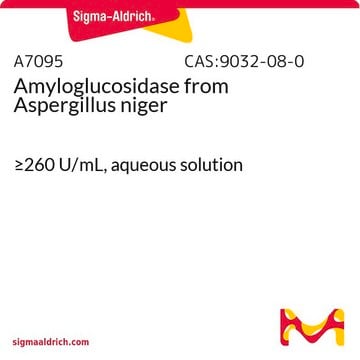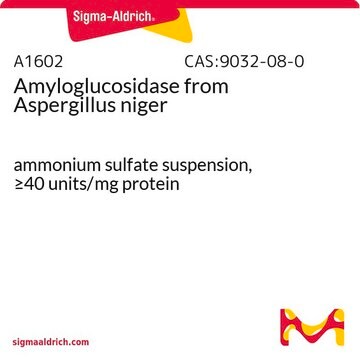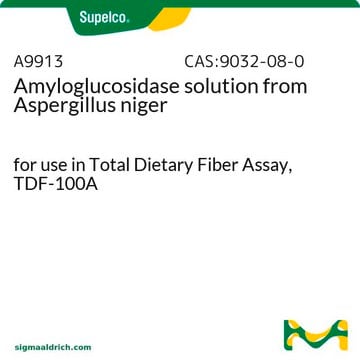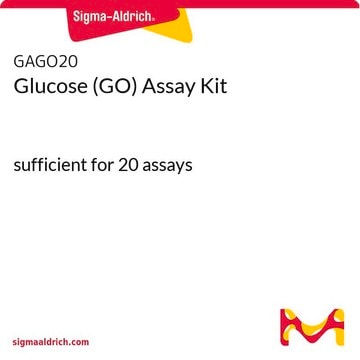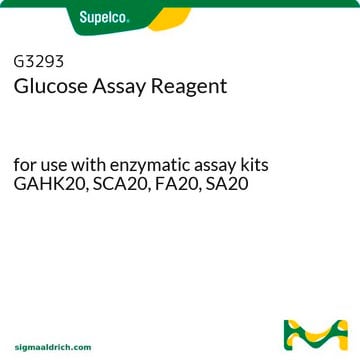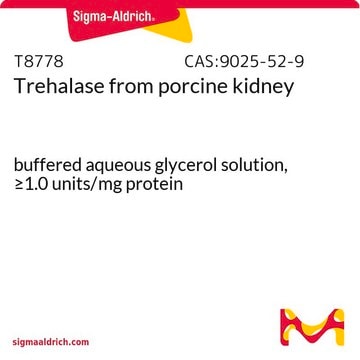The stability of this product in solution has not been evaluated. However, 172426 Glucoamylase (syn. Amyloglucosides) from Rhizopus, notes that solutions are stable when stored frozen in aliquots at -20°C for up to 3 months. Similar stability would be expected for A7420. Avoid freeze/thaw cycles of solutions.
A7420
Amyloglucosidase from Aspergillus niger
lyophilized powder, 30-60 units/mg protein (biuret), ≤0.02% glucose
Synonym(s):
1,4-α-D-Glucan glucohydrolase, Exo-1,4-α-glucosidase, Glucoamylase
About This Item
Recommended Products
form
lyophilized powder
Quality Level
specific activity
30-60 units/mg protein (biuret)
composition
protein, ≥80%
greener alternative product characteristics
Waste Prevention
Design for Energy Efficiency
Learn more about the Principles of Green Chemistry.
sustainability
Greener Alternative Product
impurities
≤0.02% glucose
greener alternative category
, Enabling
storage temp.
−20°C
Looking for similar products? Visit Product Comparison Guide
General description
Application
Biochem/physiol Actions
Unit Definition
Physical form
Other Notes
inhibitor
Signal Word
Danger
Hazard Statements
Precautionary Statements
Hazard Classifications
Resp. Sens. 1
Storage Class Code
11 - Combustible Solids
WGK
WGK 3
Flash Point(F)
Not applicable
Flash Point(C)
Not applicable
Personal Protective Equipment
Choose from one of the most recent versions:
Certificates of Analysis (COA)
Don't see the Right Version?
If you require a particular version, you can look up a specific certificate by the Lot or Batch number.
Already Own This Product?
Find documentation for the products that you have recently purchased in the Document Library.
Customers Also Viewed
Protocols
This procedure may be used for the determination of Amyloglucosidase activity using starch as the substrate.
-
What is the shelf life of a solution (1 mg/mL in water) of Product A7420, Amyloglucosidase from Aspergillus niger and how should it be stored?
1 answer-
Helpful?
-
-
What is the Department of Transportation shipping information for this product?
1 answer-
Transportation information can be found in Section 14 of the product's (M)SDS.To access the shipping information for this material, use the link on the product detail page for the product.
Helpful?
-
-
How can a solution of Product A7420, Amyloglucosidase from Aspergillus niger, be prepared?
1 answer-
A 1 mg/mL solution may be prepared in water.
Helpful?
-
-
What is the molecular weight of Product A7420, Amyloglucosidase from Aspergillus niger?
1 answer-
Amyloglucosidase from A. niger exists in two isoforms with MWs of 69,810 and 89,130, as determined by SDS-PAGE. See: Starch, 34, 346 (1982).
Helpful?
-
-
Does Product A7420, Amyloglucosidase from Aspergillus niger, contain any stabilizers or additives?
1 answer-
The starting material for Product No. A7420 is Product No. A3042, which is a preparation of the enzyme in a 1 M glucose solution. This is dialyzed against water until the glucose concentration is less than 0.02%, and then lyophilized.
Helpful?
-
Active Filters
Our team of scientists has experience in all areas of research including Life Science, Material Science, Chemical Synthesis, Chromatography, Analytical and many others.
Contact Technical Service